
This runestone, listed in Rundata as runic inscription U 1011, was carved in the 11th century and was originally located at Örby, Rasbo, Sweden.

The Hillersjö stone, listed in the Rundata catalog as U 29 and located at Hillersjö, which is about four kilometers north of Stenhamra on Färingsö, is a runic Younger Futhark inscription that tells, in Old Norse, the tragic real life family saga of Gerlög and her daughter Inga. It is the longest runic inscription in Uppland and the second longest one in Sweden after the Rök runestone.
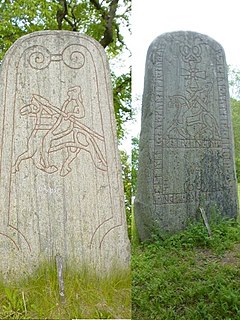
U 678 is the Rundata catalog number for a Viking Age image stone with a runic inscription located in Skokloster, Uppland, Sweden.

The Stone of Eric, listed as DR 1 in the Rundata catalog, is a memorial runestone that was found in Northern Germany. This area was part of Denmark during the Viking Age.

Fot was a runemaster who flourished in mid-11th century Sweden.
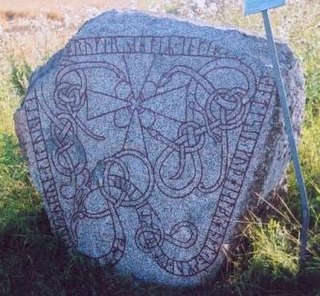
Åsmund Kåresson was a Viking Age runemaster who flourished during the first half of the 11th century in Uppland and Gästrikland, Sweden. The early Urnes style is represented in his art.
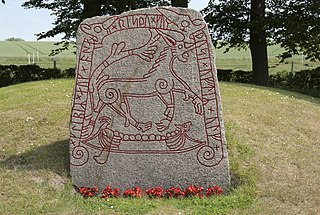
The Tullstorp Runestone is a Viking Age memorial runestone, listed as DR 271 in the Rundata catalog, that is located in Tullstorp, which is about twenty kilometers east of Trelleborg, Skåne County, Sweden, and in the historic province of Scania.
There were probably two Gunnar's bridge runestones at Kullerstad, which is about one kilometre northeast of Skärblacka, Östergötland County, Sweden, which is in the historic province of Östergötland, where a man named Håkon dedicated a bridge to the memory of his son Gunnar. The second stone was discovered in a church only 500 metres away and is raised in the cemetery. The second stone informs that Håkon raised more than one stone in memory of his son and that the son died vestr or "in the West."
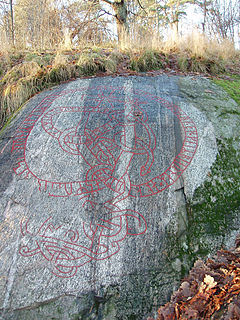
Runic inscription U Fv1986;84 is the Rundata catalog number for a Viking Age memorial that is located at Bo gård on the island of Lidingö in Uppland, Sweden.

This runic inscription, designated as U 839 in the Rundata catalog, is on a Viking Age memorial runestone located in Ryda kungsgård, which is about 6 kilometers north of Enköping, Uppsala County, Sweden, and in the historic province of Uppland.
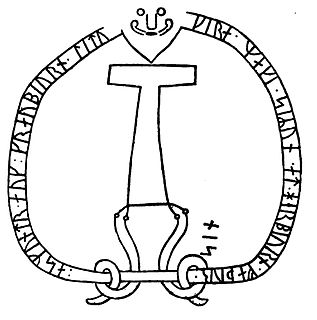
Sö 86 is the Rundata catalog number for a Viking Age memorial runic inscription located in Åby, which is about one kilometer north of Ålberga, Södermanland County, Sweden, and in the historic province of Södermanland. The inscription features a depiction of the hammer of the Norse pagan god Thor named Mjöllnir and a facial mask.

This runic inscription, designated as U Fv1976;104 in the Rundata catalog, is on a Viking Age memorial runestone that is located at the Uppsala Cathedral, Uppland, Sweden.

Uppland Runic Inscription 227 or U 227 is the Rundata catalog designation for a Viking Age memorial runestone that is located in Grana, which is about 4 kilometers west of Vallentuna, Stockholm County, Sweden, and in the historic province of Uppland.

Södermanland Runic Inscription 158 or Sö 158 is the Rundata catalog number for a Viking Age memorial runestone located in Österberga, which is one kilometer southwest of Ärsta and three kilometers southwest of Runtuna, Södermanland County, Sweden, and in the historic province of Södermanland. The inscription includes an image of a ship and uses same-stave bind runes to commemorate a man described as being a thegn.

Sö Fv1948;295 is the Rundata catalog number for a Viking Age memorial runestone that is located in Prästgården, which is just west of Jönåker, Södermanland County, Sweden. It commemorates two men who are described as being thegns.
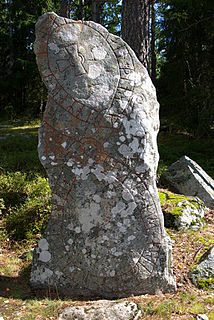
Sö 292 is the Rundata catalog number for a Viking Age memorial runestone located in Bröta, which is about six kilometers southwest of Väländan, Stockholm County, Sweden, in the historic province of Södermanland.

Sö 298 is the Rundata catalog number for a Viking Age memorial runestone located in Uringe Malm, which is about four kilometers west of Väländan, Stockholm County, Sweden, in the historic province of Södermanland.

Södermanland Runic Inscription 352 or Sö 352 is a Viking Age memorial runestone located at Linga, which is about two kilometers south of Järna, Stockholm County, Sweden, which was in the historic province of Södermanland. The inscription depicts a ship with an anchor and a portion of the runic text uses same-stave bind runes on the ship mast.

Södermanland Runic Inscription 351 or Sö 351 is the Rundata catalog number of a Viking Age memorial runestone located in Överjärna, which is part of Järna, Stockholm County, Sweden, which was part of the historic province of Södermanland. The damaged inscription depicts a ship and the text names the killer of the decedent.
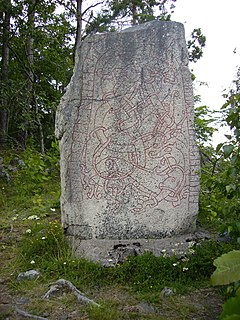
The Nasta Runestone, listed as Nä 34 in the Rundata catalog, is a Viking Age memorial runestone located in Nasta, which is 3 kilometers northwest of Glanshammar, Örebro County, Sweden, which was in the historic province of Närke.



















